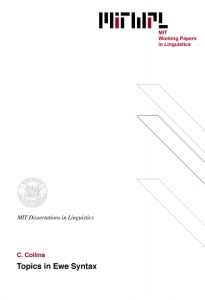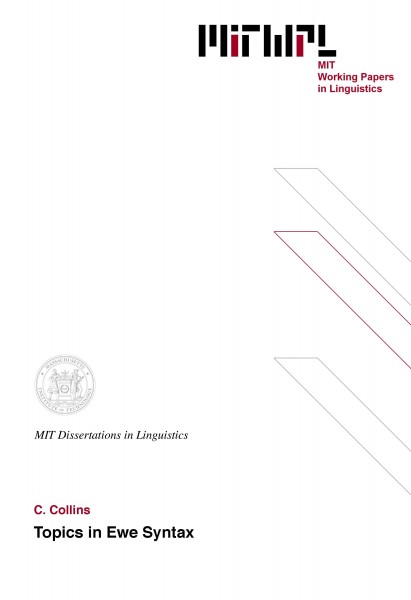Topics in Ewe Syntax
C. Collins, 1993
This thesis analyzes a number of problems in Ewe syntax. Its goal is to show how several difficult problems in Ewe syntax have natural treatments in the generative framework, and how these problems bear on current theoretical issues.
Chapter one gives a brief overview of the assumptions that are adopted in this thesis. The assumptions of this thesis are largely those of Chomsky (1992) and Hale and Keyser (1993).
Chapter two gives an analysis of determiner doubling in Ewe. In this construction the third person singular object pronoun doubles a DP that does not have structural Case. Determiner doubling is analyzed as a kind of default Case assignment. Its precise distribution has important consequences for the grammar of Ewe, including the analysis of Serial Verb Constructions (SVCs), the verbal noun constructions, and A’-movement.
This system of default Case found in Ewe will be suited in a general theory of default Case, including Yoruba ni and Russian instrumental. The implications of default Case are drawn for the general theory of Case given in Chomsky (1992).
Chapter three gives a theory of Serial Verb Constructions (SVCs). The main assumptions that are made are that SVCs involve LF incorporation and that “argument sharing” is mediated by empty categories. These two assumptions lead to an account of many subtle phenomena concerning SVCs.
Chapter four gives an analysis of how the form of the third person singular subject pronoun depends on movement to Spec CP. The analysis is extended to successive cyclic movement, where it is shown that principles of economy of derivation play a role.
Thesis Supervisor: Kenneth Hale
<br/>
Table of Contents
Chapter 1: Introduction
1.1 Theoretical framework
1.2 Language background
1.3 Overview
Chapter 2: Determiner Doubling and the Theory of Default Case
2.1 Introduction
2.2 Theoretical assumptions
2.3 The object pronouns
2.4 yi in determiner doubling constructions
2.4.1 The structure of determiner doubling
2.4.2 Case assignment and determiner doubling
2.4.3 The relation of doubling yi to pronominal yi
2.5 Predicate DPs
2.6 DPs with structural case
2.6.1 The direct object
2.6.2 A-movement in Ewe and the verbal noun
2.6.3 The nya-construction
2.6.4 Other structural case positions
2.7 Indirect objects and A’-movement
2.8 Verb serialization and argument sharing
2.9 The single yi constraint
2.10 Implications for Case Theory
2.10.1 Predicates and Case Theory
2.10.2 Other systems of default case
2.10.3 Some general remarks on default case
2.11 Conclusion
Chapter 3: Empty Categories and Serial Verb Constructions
3.1 Introduction
3.2 Preliminary issues
3.2.1 Range of constructions
3.2.2 LF incorporation in SVCs
3.2.3 Argument sharing and SVCs
3.2.4 Outline
3.3 V2 is unaccusative
3.3.1 Existence and position of the empty category
3.3.2 The nature of the empty category
3.3.3 Spec VP and the empty category
3.3.4 The direct object restriction on resultatives
3.3.5 Implications for resultatives
3.3.6 Object of V1 is agent of V2
3.3.7 Double unaccusatives
3.3.8 Double unaccusatives and Gruber’s paradigm
3.4 Object of V1 is instrument of V2
3.4.1 The projection of ku “with” in SVCs
3.4.2 The status of instruments as arguments
3.5 Direct object sharing
3.5.1 V2 undergoes causative/inchoative alternation
3.5.2 Other examples of V2 transitive
3.5.3 More evidence for object sharing as predication
3.5.4 V2 is ditransitive
3.6 Object sharing and adjuncts
3.7 SVCs with three verbs
3.8 Cross linguistics variation
3.8.1 Kwa vs. Bantu
3.8.2 Ewe vs. Igbo
3.8.3 Ewe vs. English
3.9 Conclusion
Chapter 4: The 3sg Subject Pronoun and Successive Cyclicity
4.1 Introduction
4.2 Preliminaries
4.2.1 Status of the subject pronouns
4.2.2 Clause structure
4.2.3 Nominative case assignment
4.2.4 The structure of COMP
4.3 wo-selection
4.3.1 T to C at LF
4.3.2 3rd person AGR is inert
4.3.3 Analysis of wo
4.3.4 Lexical subjects
4.3.5 Negation and the future
4.3.6 Sentential connectives
4.4 Successive cyclic movement
4.4.1 Position of A’-t and wo
4.4.2 Economy of derivation
4.4.3 Other applications
4.4.4 Optional vs. Obligatory
4.4.5 Inherent vs. Relational features
4.5 Other contexts of wo-selection
4.6 Conclusion

